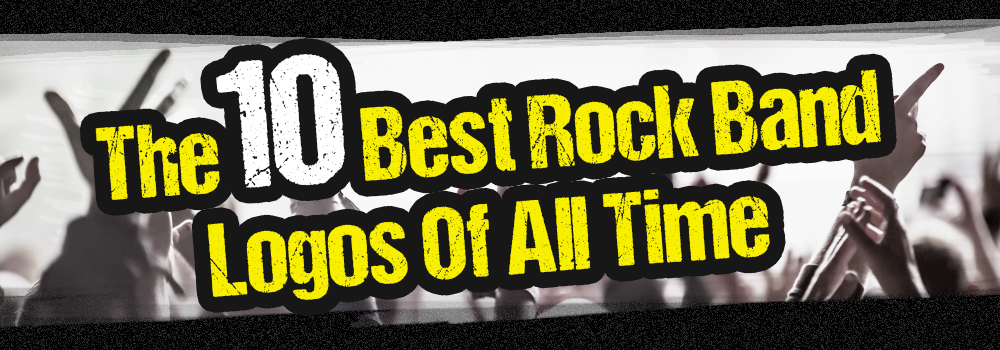The musicians. The music. The tours. The lights. The drugs. The fame. The fans. The logos…
From the early 1960s until the mid 1980s, we were blessed with the birth of an incredible number of insanely talented rock and roll bands. These bands brought a raw energy and power to the stage that hadn’t been seen before. Performing in front of sold out crowds in venue after venue all over the world, these bands formed what many of us today consider the solid foundation of the true Rock Band.
To write this article, an online poll asked voters to choose their five favorite rock band logos of all time from a list of twenty incredible logo designs. The winner was clearly in the lead from the very start which came as no surprise. Once the results were tallied, research was conducted to learn about the artist who created the logo design, where the logo first appeared, and the meaning behind each design. It’s not easy to create a logo that’s powerful enough to represent 10 of the most influential bands of all time. It’s not easy to match that level of greatness. Yet, these artists were able to do just that. Read about these iconic designs and, as always, keep on rockin’.
Designer: Storm Thorgerson and Aubrey Powell
First Appearance: Album cover art for Houses of the Holy
The logotype is an elegant and masterful portrayal of the band’s name which displays the dynamic quality and magnificence of Led Zeppelin’s music. Though the font may look simple, it’s actually a hand-drawn typeface. Each letter is disproportionate. Thorgerson has explained that by creating this hand-drawn design, he was trying to capture the psychedelic and experimental music of Zeppelin. The figure (referred to as the “Swan Song logo”) was inspired by an obscure 19th century painting by American artist, William Rimmer, called “Evening (Fall of the Day)” (see it here) which is a painting of Apollo, the Greek god of light, music and healing.
Designer: Storm Thorgerson
First Appearance: Album cover art for Dark Side of the Moon
Pink Floyd has used various logos throughout their history, but the most distinctive one is the triangular prism designed by graphic designer, Storm Thorgerson, for the cover of their album “Dark Side of the Moon.” In this design, we see a light passing through a geometric shape. The light is thin then dispersed into 6 colors (the typical prism displays 7 colors) once it travels through the prism. This prism represents 3 elements: the band’s stage lighting, the album lyrics, and keyboardist Richard Wright’s request for a “simple and bold” design. Thorgerson explained the idea behind the prism was to replicate a light show. The triangular shape, he said, is a symbol of “thought and ambition” which was often the subject of Roger Water’s lyrics. This design has been called one of the greatest album covers of all time.
Designer: Based on a sketch by Ivor Arbiter, owner of Drum City in London
First Appearance: On Ringo’s drum kit in 1963
The Beatles band manager, Brian Epstein, along with Ringo, visited Drum City looking for a drum kit. The Premier kit Ringo had been using was worn and in need of replacement. They’d planned on purchasing an all black kit, but Ringo was more interested in a Ludwig set he saw. Epstein didn’t want to pay for the drums so he negotiated with the store’s owner. Eventually Arbiter agreed to trade the drums in return for Ringo’s battered old Premier kit. One condition was the Ludwig name would have to appear on the drum bass head since Arbiter had recently begun a distribution deal with the company. Epstein agreed but asked that the The Beatles’ name be added to it as well. Arbiter quickly sketched the iconic logo which was then added to the drum kit by local sign painter, Eddie Stokes. The capital B and drop T was a way to emphasize the word “Beat.” Arbiter was paid 5 pounds for the design.
Designer: Owsley Stanley, rendered by Bob Thomas
First Appearance: Used as a mark on the band’s equipment
The “Lightning Skull” logo was originally created to mark equipment cases. Owsley was inspired by a freeway sign he’d seen that was a round shape divided by a bold white line. Half of the shape was orange and the other half blue. Originally, there was no skull. It was just the circle and lighting bolt. A skull face was added shortly after to symbolize the “Grateful Dead.” It’s been referred to as the “Steal Your Face” symbol as well since appearing on the album cover of the same name. The artist has described the symbol as explaining the experience fans have when listening to the band’s music. They are “transformed.”
Designer: Ray Tabano (ex-guitarist of Aerosmith)
First Appearance: Album cover art for Get Your Wings
Tabano was only a member of Aerosmith for one year, but his contribution as the band’s logo designer has lived on, becoming one of the greatest rock band logos of all time. This logo has become one of the most widely recognized images in rock. Referred to as the “winged-A” design, the logo is a large letter A with wings. The wings represent freedom. It’s believed the circled letter A is a symbol of anarchy, and the psychedelic-style font used for the band’s name brings in their early roots.
Designer: Ace Frehley (Lead Guitarist)
First Appearance: Album cover art for Hotter ‘N Hell
The band was originally known as Wicked Lester before changing their name to Kiss after Frehley joined. Ace scribbled a version of the new name on a poster that was outside of a club where the band was scheduled to play, replacing Wicked Lester with Kiss. It’s been said the double S’s were meant to represent lightning bolts. In 1979, these double S’s in runic letters were so similar to the insignia of the Nazi SS that the German government confiscated Kiss albums and banned the logo entirely. It is illegal to display this symbol in Germany. Since then, Kiss album covers and all Kiss merchandise sold in Germany uses a modified version of the logo that features 2 backward Z’s (see here). Though it’s been rumored that Ace Frehley had a fascination with Nazism, when asked in a 2011 interview about this, Frehley claimed that the connection was false. “I’ll go on record saying it wasn’t modeled after Hitler or Nazis. I want to go on record saying I don’t believe in Hitler or his ideology or anything he stood for.” He claims the reason he drew the S’s the way he did was simply because he liked lightning bolts. Nothing more.
Designer: Slash (Lead Guitarist)
Slash hand drew the original logo. The name of the band came together from the two failed bands which the musicians came from, LA Guns and Hollywood Rose. The logo was designed to portray the band’s intense nature. We see two classic guns entwined with roses and thorns. Often overlooked, there are tiny drops of blood falling from the roses. This symbolizes danger, menace, and pain, which is often subject matter of the band’s song lyrics. The colors used in the design, red, yellow, green, black and silver, are representative of the passion, rebellion, power and energy that has defined Guns N Roses for decades.
Designer: Bob Defrin (art director of Atlantic Records) and Gerard Huerta
First appearance: Album cover art for Let There Be Rock
Brothers Malcolm and Angus Young decided on the name AC/DC for their band after seeing it on their sister’s sewing machine. AC/DC is an abbreviation for alternating current/direct current. These are references to electric signals and voltages which explains the bolt in the logo design. The name, they thought, was a symbol of the raw energy and powerful performances of their music. The AC/DC logo is based on gothic lettering to give the logo “weight” which is the font found in Gutenberg’s Bible (see here). Huerta has explained his intention was to create a logo that would match the biblical imagery of the song “Let There Be Rock.” Though the added lightning bolt and red color suggest something not quite so angelic.
Designer: Dave Bhang
First appearance: Album cover for their debut album Van Halen
The famous VH logo design came about after Warner Bros. designed the original cover art for the band’s debut album. At the time, the Punk movement was huge. Artists at Warner Bros. used a jagged script to spell out Van Halen overtop a black and white photo of the four band members (see here). Van Halen refused the cover design. They complained it made them look like The Clash. Designer Dave Bhang was hired to redesign the cover, coming up with the tile design of 4 photos of the different band members taken during a live performance topped with the a silver VH logo in the center of the cover (see here). Van Halen instantly approved the new design because they said the design made it clear they have nothing to do with the Punk movement. Van Halen was about rock and roll. The iconic logo has undergone a few alterations over the years just as the band has. But the VH logo is still the symbol that screams “Van Halen.”
Designer: Art student at the Royal College of Art, John Pasche
First appearance: Album cover art for Sticky Fingers
Mick Jagger approached the Royal College of Art looking for an artist to create images for the band. He met John Pasche. “Face to face with him, the first thing you were aware of was the size of his lips and his mouth,” Pasche has said. The design, Pasche explained, was a combination of Jagger’s mouth and Kali, the Goddess of Time, Creation, Destruction and Power. Jagger asked Pasche to create something that portrayed a never ending energy similar to what the goddess represents. Kali is a Hindu goddess associated with empowerment. She’s often seen with her tongue sticking out (see here). Pasche also said he felt the tongue alluded to the “anti-authoritarian attitude” that the band represents. In survey after survey, the “Tongue and Lip Design” logo continues to rank the number one rock band logo of all time.













